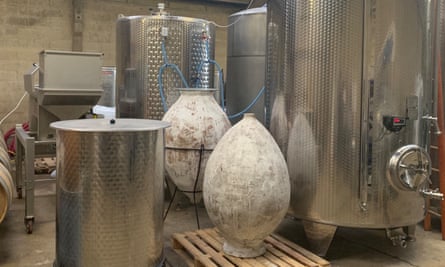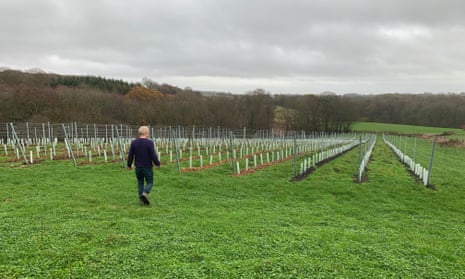In a coppiced corner of Dew farm, deep in the rolling Sussex Weald, grows a wild grapevine: ancient, gnarled and bountiful. When Ben Walgate moved here last year, he wild-fermented grapes from the vine and found he had made a wine that, as he put it, “tasted of the place”.
Now Walgate, who comes from a long line of farmers, is creating a vineyard – Tillingham Wines – using that vine as inspiration. Instead of the intensive and chemical-dependent practices of traditional viticulture, Walgate, with the collaboration of the owner of the estate, the conservationist Lord Devonport, wants to establish a vineyard that echoes as closely as possible the natural, biodiverse, humus- and microbe-rich soil environment in which wild vines thrive.
First Walgate mulched 25 acres of the 100-acre plot with 1,000 tonnes of compost that had been enriched with a variety of biodynamic treatments. He admits he is not about to go burying yarrow flowers in a sun-dried deer’s bladder. More important, he says, is the link that biodynamic processes give to the microbial health of the soil.
In a barn he shows me his store of sweet-smelling, gluey cow-horn manure – a highly potent source of microbes that he buries, one horn to an acre, and which are, he says, “microbial dynamite”, enriching soil that has been stripped of its microscopic life by years of pesticide-heavy arable farming.

In May, Walgate hand-planted his first 10,000 vines amid a ley of clover. Now, on a mild winter’s day, the wildflower borders that surround the vineyards have packed themselves up for the year, the oaks and beech that line the gill – a local term for a steep-sided gulch – burst in a final conflagration of colour, and the vines huddle beneath a thick compost mulch.
In the basement of a half-ruined oast house attached to the farm, buried in the ground are a dozen Georgian qvevri – huge terracotta urns used for millennia to ferment wine. Like the rest of the project at Tillingham, they point to a way of thinking about agriculture that is slower and more labour-intensive, and which looks to the past to shape the future of farming.

Comments (…)
Sign in or create your Guardian account to join the discussion